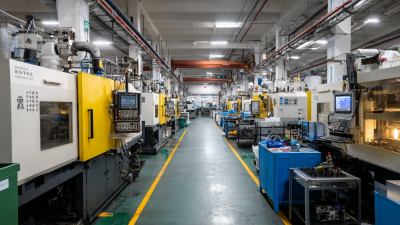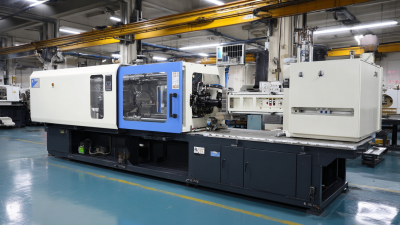Innovative Uses of Plastic Injection Molding in Sustainable Product Design
In recent years, the shift towards sustainable product design has prompted significant innovations in various manufacturing processes, particularly in plastic injection molding. According to a report by the Plastic Industry Association, the plastic injection molding market is expected to reach $263 billion by 2027, demonstrating the growing demand for efficient and sustainable manufacturing solutions. This process not only allows for complex designs but also facilitates the use of recycled materials, aligning with global sustainability goals.
Industry expert Dr. Emily Carter, a leading figure in sustainable manufacturing, has emphasized the transformative potential of this technology. She stated, "Plastic injection molding can revolutionize how we design and produce products, offering solutions that not only meet consumer demands but also contribute to a circular economy." As businesses strive to balance performance with environmental responsibility, the innovative applications of plastic injection in sustainable product design are proving to be a viable pathway. This article explores the top ten innovative uses of plastic injection molding that exemplify the industry’s commitment to sustainability while maintaining high standards of quality and efficiency.

Emerging Trends in Sustainable Materials for Plastic Injection Molding
The emphasis on sustainable materials in plastic injection molding is reshaping the industry, aligning with the increasing market size projected to reach USD 580.44 billion by 2033. Innovative approaches to material selection are being adopted, focusing on biodegradable and recycled plastics to minimize environmental impact. The move toward sustainable production not only addresses ecological concerns but also appeals to consumers who are increasingly aware of their choices.
Emerging trends reflect a commitment to reducing waste and enhancing recyclability in product design. For instance, manufacturers are exploring bio-based polymers and other eco-friendly alternatives that fulfill performance requirements while ensuring a lower carbon footprint. As the injection molding machinery market continues to thrive, with a significant market share attributed to its precision and efficiency, the integration of sustainable practices promises to drive both innovation and growth in the years to come.
Innovative Uses of Plastic Injection Molding in Sustainable Product Design
| Application Area | Sustainable Material Type | Benefits | Emerging Trends |
|---|---|---|---|
| Consumer Products | Biodegradable Plastics | Reduced environmental impact, compostable options | Increased consumer awareness and demand for eco-friendly products |
| Packaging Solutions | Recycled PET (rPET) | Waste reduction, lower carbon footprint | Adoption in food packaging and sustainable branding |
| Automotive Components | Natural Fiber Reinforced Plastics | Lightweight materials, improved fuel efficiency | Integration with electric vehicle designs |
| Construction Materials | Post-consumer Recycled Plastics | Durability, lower environmental impact | Rise in sustainable architecture and building practices |
| Medical Devices | Bio-based Polymers | Safety for patients, reduced ecological footprint | Increasing regulations for biocompatibility |
Design Innovations: Eco-friendly Products from Plastic Waste
In recent years, the push for sustainable product design has led to innovative uses of plastic injection molding, particularly in creating eco-friendly products from plastic waste. The global recycled plastic packaging market is estimated to surpass $27.76 billion in 2023, and it is projected to grow at a compound annual growth rate (CAGR) of around 10% from 2024 to 2032. This significant growth highlights a shifting consumer preference toward sustainable solutions, driven by the increasing awareness of plastic pollution and its environmental impact.
Notably, the eco-friendly straws market is expected to expand from $3.98 billion in 2023 to $7.5 billion by 2032, suggesting a CAGR of 7.3% during the forecast period. This trend reflects a broader movement among consumers who prioritize sustainability, with 89% reporting a preference for purchasing environmentally friendly products. Furthermore, the agricultural film market is also witnessing growth, projected to rise from $2.24 billion in 2025 to $4.47 billion by 2034, showcasing an 8% CAGR. These figures underscore the vitality of innovative design in transforming plastic waste into functional, sustainable products, demonstrating that environmental considerations are increasingly influencing design choices across various industries.
Innovative Uses of Plastic Injection Molding in Sustainable Product Design
This bar chart illustrates the percentage of various innovative products manufactured using plastic injection molding from recycled plastics, emphasizing the shift towards sustainable design practices.
Reducing Carbon Footprint: Efficient Injection Molding Techniques
The ongoing pursuit of sustainability in product design has led to the emergence of efficient injection molding techniques, significantly reducing carbon footprints in manufacturing. Recent advancements in low-pressure injection molding have proven to be game-changers, attaining a reduction in energy consumption by 10-15% compared to traditional methods. This shift not only conserves power but also enhances the overall sustainability of the manufacturing process, thus contributing to a greener industry.
To support these innovative practices, companies are increasingly focusing on materials that further diminish environmental impacts. The use of carbon fiber reinforced thermoplastics (CFRTs) represents a vital step towards high-performance, sustainable products. Their lightweight and durable nature paves the way for enhanced design possibilities without compromising eco-friendliness. For instance, utilizing renewable resources in the production cycle can significantly lower product carbon footprints, showcasing a robust commitment to sustainability.
Tips for Sustainable Injection Molding:
- Consider implementing low-pressure molding techniques to minimize energy requirements and waste.
- Explore biodegradable materials or recycled plastics to contribute to a circular economy while reducing reliance on virgin resources.
- Optimize manufacturing processes with smart technologies that monitor and improve efficiency, thereby lowering energy consumption and emissions.
Case Studies: Successful Applications of Injection Molding in Green Design
Plastic injection molding is being increasingly embraced in the realm of sustainable product design. Through various innovative case studies, companies are showcasing how this technique can lead to environmentally friendly solutions without compromising on functionality or aesthetics. For instance, a leading manufacturer of consumer goods recently developed a range of biodegradable products by utilizing plant-based polymers in their injection molding processes. This not only reduces the carbon footprint but also enables products to decompose safely after their lifecycle.
Tips for integrating sustainable practices in injection molding include opting for recycled materials and ensuring that the design is optimized for minimal waste. Companies can adopt a circular design approach, where products are created with end-of-life considerations, allowing consumers to return items for recycling. Another successful example is a furniture design brand that uses injection molding for creating modular pieces from upcycled plastics, effectively reducing landfill waste while providing stylish and functional furniture solutions.
As more organizations pivot towards sustainability, exploring innovative applications in plastic injection molding can enhance their product offerings while attracting eco-conscious consumers. Sustainability in manufacturing isn't just a trend; it's becoming a crucial aspect of competitive advantage in today’s market.
Future Perspectives: The Role of Technology in Sustainable Product Development
Plastic injection molding has emerged as a pivotal technology in the landscape of sustainable product development. It enables manufacturers to create complex shapes with minimal waste, contributing to the efficient use of materials. According to a report by MarketsandMarkets, the plastic injection molding market is projected to reach USD 345.83 billion by 2027, reflecting a compound annual growth rate (CAGR) of 4.7% during the forecast period. This growth is fueled by increasing consumer demand for sustainable products, prompting companies to innovate their processes and materials.
As technology advances, sustainable practices in plastic injection molding are becoming more sophisticated. The integration of advanced simulations and 3D printing in the design phase allows for more precise and efficient production cycles. Research from the Journal of Cleaner Production highlights that utilizing bio-based and recycled materials in injection molding can reduce the carbon footprint of products by up to 60%. Furthermore, emerging technologies such as AI and IoT facilitate the optimization of production lines, enhancing not only efficiency but also sustainability. In this way, the role of technology in plastic injection molding is instrumental in shaping a more eco-friendly future for product design.
Related Posts
-

Unlocking Precision: A Comprehensive Guide to Best Rapid Injection Molding Specifications and Techniques
-

10 Reasons Rapid Injection Molding is the Best Choice for Your Production Needs
-

The Definitive Ultimate Guide to Sourcing the Perfect Injection Machine for Your Business Needs
-

Mastering the Art of Injection Molded Parts Production A Comprehensive Tutorial on Techniques and Best Practices
-

Ultimate Guide to Mastering Plastic Molding Techniques for Your Business
-

Unlocking the Future of Product Development with Rapid Injection Molding Techniques